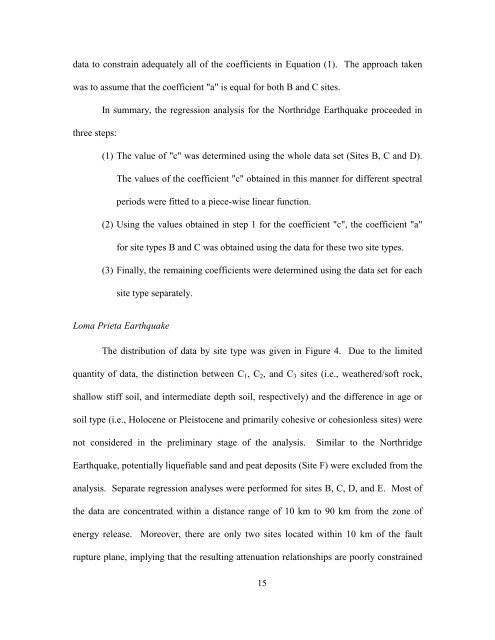Report - PEER - University of California, Berkeley
Report - PEER - University of California, Berkeley
Report - PEER - University of California, Berkeley
- No tags were found...
You also want an ePaper? Increase the reach of your titles
YUMPU automatically turns print PDFs into web optimized ePapers that Google loves.
data to constrain adequately all <strong>of</strong> the coefficients in Equation (1). The approach takenwas to assume that the coefficient "a" is equal for both B and C sites.In summary, the regression analysis for the Northridge Earthquake proceeded inthree steps:(1) The value <strong>of</strong> "c" was determined using the whole data set (Sites B, C and D).The values <strong>of</strong> the coefficient "c" obtained in this manner for different spectralperiods were fitted to a piece-wise linear function.(2) Using the values obtained in step 1 for the coefficient "c", the coefficient "a"for site types B and C was obtained using the data for these two site types.(3) Finally, the remaining coefficients were determined using the data set for eachsite type separately.Loma Prieta EarthquakeThe distribution <strong>of</strong> data by site type was given in Figure 4. Due to the limitedquantity <strong>of</strong> data, the distinction between C 1 , C 2 , and C 3 sites (i.e., weathered/s<strong>of</strong>t rock,shallow stiff soil, and intermediate depth soil, respectively) and the difference in age orsoil type (i.e., Holocene or Pleistocene and primarily cohesive or cohesionless sites) werenot considered in the preliminary stage <strong>of</strong> the analysis. Similar to the NorthridgeEarthquake, potentially liquefiable sand and peat deposits (Site F) were excluded from theanalysis. Separate regression analyses were performed for sites B, C, D, and E. Most <strong>of</strong>the data are concentrated within a distance range <strong>of</strong> 10 km to 90 km from the zone <strong>of</strong>energy release. Moreover, there are only two sites located within 10 km <strong>of</strong> the faultrupture plane, implying that the resulting attenuation relationships are poorly constrained15
















